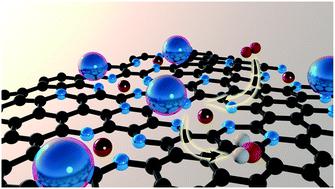当前位置:
X-MOL 学术
›
Energy Environ. Sci.
›
论文详情
Our official English website, www.x-mol.net, welcomes your
feedback! (Note: you will need to create a separate account there.)
Atomically dispersed Fe–N–C decorated with Pt-alloy core–shell nanoparticles for improved activity and durability towards oxygen reduction
Energy & Environmental Science ( IF 32.4 ) Pub Date : 2020-07-16 , DOI: 10.1039/d0ee00832j Xiang Ao 1, 2, 3, 4, 5 , Wei Zhang 6, 7, 8, 9 , Bote Zhao 1, 2, 3, 4 , Yong Ding 1, 2, 3, 4 , Gyutae Nam 1, 2, 3, 4 , Luke Soule 1, 2, 3, 4 , Ali Abdelhafiz 1, 2, 3, 4 , Chundong Wang 5, 9, 10, 11, 12 , Meilin Liu 1, 2, 3, 4
Energy & Environmental Science ( IF 32.4 ) Pub Date : 2020-07-16 , DOI: 10.1039/d0ee00832j Xiang Ao 1, 2, 3, 4, 5 , Wei Zhang 6, 7, 8, 9 , Bote Zhao 1, 2, 3, 4 , Yong Ding 1, 2, 3, 4 , Gyutae Nam 1, 2, 3, 4 , Luke Soule 1, 2, 3, 4 , Ali Abdelhafiz 1, 2, 3, 4 , Chundong Wang 5, 9, 10, 11, 12 , Meilin Liu 1, 2, 3, 4
Affiliation

|
One of the key challenges that hinders broad commercialization of proton exchange membrane fuel cells is the high cost and inadequate performance of the catalysts for the oxygen reduction reaction (ORR). Here we report a composite ORR catalyst consisting of ordered intermetallic Pt-alloy nanoparticles attached to an N-doped carbon substrate with atomically dispersed Fe–N–C sites, demonstrating substantially enhanced catalytic activity and durability, achieving a half-wave potential of 0.923 V (vs. RHE) and negligible activity loss after 5000 cycles of an accelerated durability test. The composite catalyst is prepared by deposition of Pt nanoparticles on an N-doped carbon substrate with atomically dispersed Fe–N–C sites derived from a metal–organic framework and subsequent thermal treatment. The latter results in the formation of core–shell structured Pt-alloy nanoparticles with ordered intermetallic Pt3M (M = Fe and Zn) as the core and Pt atoms on the shell surface, which is beneficial to both the ORR activity and stability. The presence of Fe in the porous Fe–N–C substrate not only provides more active sites for the ORR but also effectively enhances the durability of the composite catalyst. The observed enhancement in performance is attributed mainly to the unique structure of the composite catalyst, as confirmed by experimental measurements and computational analyses. Furthermore, a fuel cell constructed using the as-developed ORR catalyst demonstrates a peak power density of 1.31 W cm−2. The strategy developed in this work is applicable to the development of composite catalysts for other electrocatalytic reactions.
中文翻译:

原子分散的Fe–N–C修饰为Pt合金核-壳纳米颗粒,以提高活性和抗氧还原性
阻碍质子交换膜燃料电池的广泛商业化的关键挑战之一是氧还原反应(ORR)催化剂的高成本和性能不足。在这里,我们报告了一种复合ORR催化剂,该催化剂由有序金属间Pt合金纳米颗粒附着到具有原子分散的Fe–N–C位置的N掺杂碳基质上组成,证明其催化活性和耐用性大大提高,半波电势为0.923 V (与 RHE)和经过5000次循环的加速耐久性试验后的活性损失可忽略不计。复合催化剂是通过将Pt纳米颗粒沉积在N掺杂的碳基质上而制备的,该基质具有原子分散的Fe–N–C位点,该位点源自金属有机骨架,并随后进行了热处理。后者导致形成有序金属间Pt 3的核壳结构Pt合金纳米颗粒M(M = Fe和Zn)为核,壳表面有Pt原子,这对ORR活性和稳定性均有利。多孔Fe–N–C基体中Fe的存在不仅为ORR提供了更多的活性位点,而且有效地增强了复合催化剂的耐久性。如实验测量和计算分析所证实的,观察到的性能增强主要归因于复合催化剂的独特结构。此外,使用已开发的ORR催化剂构造的燃料电池表现出1.31Wcm -2的峰值功率密度。这项工作中开发的策略适用于开发其他电催化反应的复合催化剂。
更新日期:2020-09-16
中文翻译:

原子分散的Fe–N–C修饰为Pt合金核-壳纳米颗粒,以提高活性和抗氧还原性
阻碍质子交换膜燃料电池的广泛商业化的关键挑战之一是氧还原反应(ORR)催化剂的高成本和性能不足。在这里,我们报告了一种复合ORR催化剂,该催化剂由有序金属间Pt合金纳米颗粒附着到具有原子分散的Fe–N–C位置的N掺杂碳基质上组成,证明其催化活性和耐用性大大提高,半波电势为0.923 V (与 RHE)和经过5000次循环的加速耐久性试验后的活性损失可忽略不计。复合催化剂是通过将Pt纳米颗粒沉积在N掺杂的碳基质上而制备的,该基质具有原子分散的Fe–N–C位点,该位点源自金属有机骨架,并随后进行了热处理。后者导致形成有序金属间Pt 3的核壳结构Pt合金纳米颗粒M(M = Fe和Zn)为核,壳表面有Pt原子,这对ORR活性和稳定性均有利。多孔Fe–N–C基体中Fe的存在不仅为ORR提供了更多的活性位点,而且有效地增强了复合催化剂的耐久性。如实验测量和计算分析所证实的,观察到的性能增强主要归因于复合催化剂的独特结构。此外,使用已开发的ORR催化剂构造的燃料电池表现出1.31Wcm -2的峰值功率密度。这项工作中开发的策略适用于开发其他电催化反应的复合催化剂。











































 京公网安备 11010802027423号
京公网安备 11010802027423号